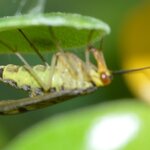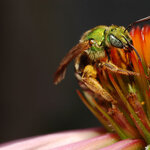Life is chemistry. You, me and every living thing – we’re all just spectacularly complex chemistry sets. Inside you, every second of the day, thousands of tiny chemical reactions are taking place.
Chemical reactions powered your transformation from a single cell into a colony of trillions of cells, and they allow you to harvest energy from the environment and transform it into yet more cells. They maintain the delicate balance in which all the components of your body function. In fact, they are that balance. They even drive your thoughts and emotions.
Most of these molecules have evolved to…
Ecology & Zoology

Many aquatic species have a reputation for negligent parenting. Having cast their gametes to the currents, they abandon their offspring to their fate. However, hands-on parenting is taken to a whole new dimension in the Syngnathidae fish family.
Instead of leaving the responsibility to the females, seahorse and pipefish males take the pledge to care for their young even before the eggs are fertilized. The females depart soon after placing their eggs directly into the male's brood pouch, leaving the soon-to-be fathers to incubate the developing embryos.
Ines Braga Goncalves from the…

Researchers have found that the severity of ranavirosis, a devastating disease that kills thousands of frogs each year, increases in the presence of exotic fish. The use of garden chemicals was also associated with increased severity of the disease.
The study highlights the risks of releasing fish into garden ponds. Fish may amplify viral levels in the environment or cause stress hormone production that reduces immune function in wild frogs. ead author Alexandra North from the Environment and Sustainability Institute at the University of Exeter's Penryn Campus in Cornwall said, "Our…

Life isn’t
always fair. Some individuals are simply born more attractive than others. In
most cases the females are the choosy ones, whereas males will try to mate as
much as possible. So being unattractive poses the largest problems for males.
In many species, males will present the female with a gift (food), because,
while she is eating she doesn’t mind having sex. However, the amount of food
given is not equal between males. In the scorpionfly, unattractive males might
not get a female quickly, but once they do, they sure know how to keep her
around for a while!
The scorpionfly
The…

A new research study showed why threatened Caribbean star corals sometimes swap partners to help them recover from bleaching events. The findings are important to understand the fate of coral reefs as ocean waters warm due to climate change.
The University of Miami (UM) Rosenstiel School of Marine and Atmospheric Science research team placed colonies of Caribbean star coral (Orbicella faveolata) in a heated tank for one to two weeks to replicate ocean conditions that would lead to both mild and severe coral “bleaching” – when corals turn white as a result of the loss of symbiotic algae living…

A Virgin Birth - parthenogenesis - may be a big deal in human culture but among wild sawfish in Florida it is apparently downright common. A new study finds that around 3 percent of the sawfish living in a Florida estuary are apparently the products of this type of reproduction, the first evidence of this in the wild for any vertebrate animal.
Parthenogenesis is common in invertebrates but relatively rare in vertebrates. Among birds, reptiles, sharks, and now rays, parthenogenesis is thought to be triggered by an unfertilized egg absorbing a sister cell called the polar body that is…
In 2006 there was a serious decline in the number of honey bee colonies in parts of Europe and the United States and it brought renewed concern about another Colony Collapse Disorder, which had last occurred in the mid-1990s.
Bee colonies rebounded quickly and are higher than ever but the question lingered; what caused these periodic collapses? Answers ranged from pests to viruses and pesticides and studies did nothing more than conclude "it's complicated". In June of 2014(1) the Obama administration created a task force to look into it and their report and an action plan just came out…

A new analysis of Ice Age birds has revealed that many of the birds were larger - despite what is commonly believed, the authors say it reflects the richness and greater productivity of the environment in the Ice Age.
They picture an unusual mix of birds in one space, the Middle Palaeolithic (Marine Oxygen Isotope Stage 3) deposits of Pin Hole, Creswell Crags, Derbyshire in England, and a distinct Neanderthal Dawn Chorus.
“During the Ice Age just over 40 thousand years ago in the north of England Neanderthals were living in an environment which included extinct animals like woolly mammoths,…

It’s bee season and now’s the time to go outside and observe these popular insects.
Bees hold a relatively special place in people’s affections – we have them to thank for honey, of course, and they’re also essential pollinators of many food crops and wild plants.
But most bees aren’t the snazzy hive-dwelling orange and black characters we know so well. In fact, there are around 20,000 species of bee globally and just seven of these are honeybees, and the vast majority of honeybee colonies belong to only one species: Apis mellifera.
So what about the rest? Well around 250 species are…

I like to use the Sneetches With Stars analogy (I did so again two days ago) because Theodor Seuss Geisel, famously known as Dr. Seuss, was spot on with the idea that humans would find a reason to be different from one another. In the Sneetch community, when one group had a star, they were superior, and eventually a savvy businessman came along and found a way to give everyone stars (which was delightfully both capitalism and communism, kind of like Science 2.0 is) and then, as predicted, when everyone now had a star the group who originally had stars but had claimed it was just nature that…
